1. 结构体基本概念
结构体属于用户自定义的数据类型,允许用户存储不同的数据类型
2. 结构体定义和使用
语法:struct 结构体名 { 结构体成员列表 };
通过结构体创建变量的方式有三种(相当于python中的实例化对象):
-
struct 结构体名 变量名
-
struct 结构体名 变量名 = { 成员1值 , 成员2值...}
-
定义结构体时顺便创建变量
示例:
#include <iostream>
using namespace std;
// 创建学生数据类型:学生(姓名,年龄,分数)
//结构体定义
struct student
{
//成员列表
string name; //姓名
int age; //年龄
int score; //分数
}stu3; //结构体变量创建方式3
int main() {
/*
通过结构体创建变量的方式:
(1) struct Student s1
(2) struct Student s2 = {......}
(3) 在定义结构体时顺便创建结构体变量
*/
//结构体变量创建方式1
struct student stu1; //struct 关键字可以省略,即此处代码等价于student stu1;
stu1.name = "张三";
stu1.age = 18;
stu1.score = 100;
cout << "姓名:" << stu1.name << " 年龄:" << stu1.age << " 分数:" << stu1.score << endl;
//结构体变量创建方式2
struct student stu2 = { "李四",19,60 };
cout << "姓名:" << stu2.name << " 年龄:" << stu2.age << " 分数:" << stu2.score << endl;
stu3.name = "王五";
stu3.age = 18;
stu3.score = 80;
cout << "姓名:" << stu3.name << " 年龄:" << stu3.age << " 分数:" << stu3.score << endl;
system("pause");
return 0;
}总结1:定义结构体时的关键字是struct,不可省略
总结2:创建结构体变量时,关键字struct可以省略
总结3:结构体变量利用操作符 ''.'' 访问成员
扫描二维码关注公众号,回复: 17250619 查看本文章
总结4:
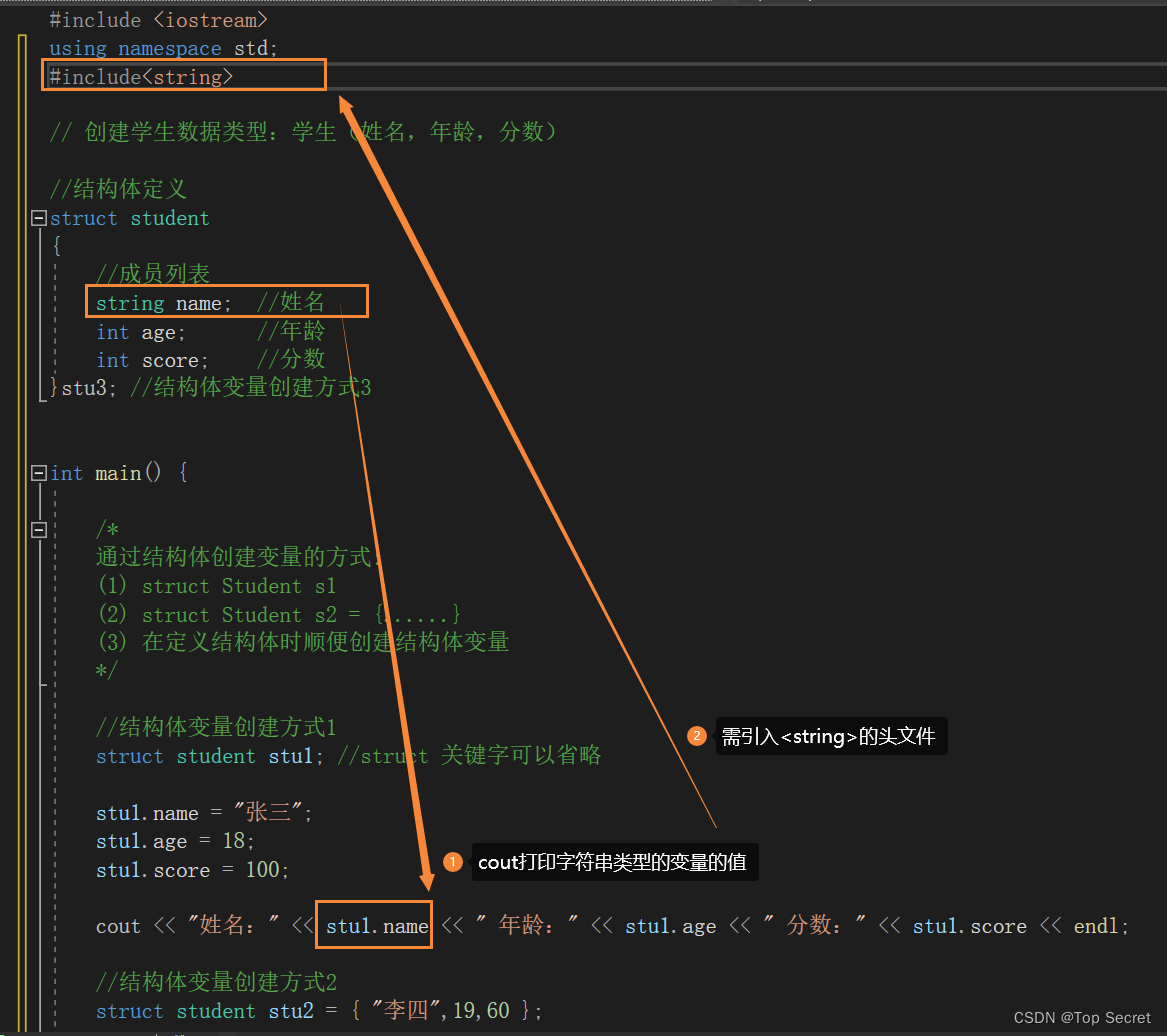
3. 结构体数组
作用:将自定义的结构体放入到数组中方便维护
语法:struct 结构体名 数组名[元素个数] = { {} , {} , ... {} }
示例:
#include <iostream>
using namespace std;
#include<string>
//结构体定义
struct student
{
//成员列表
string name; //姓名
int age; //年龄
int score; //分数
};
int main() {
//结构体数组
struct student arr[3] =
{
{"张三",18,80 },
{"李四",19,60 },
{"王五",20,70 }
};
for (int i = 0; i < 3; i++)
{
cout << "姓名:" << arr[i].name << " 年龄:" << arr[i].age << " 分数:" << arr[i].score << endl;
}
system("pause");
return 0;
}
4. 结构体指针
作用:通过指针访问结构体中的成员
-
利用操作符
->可以通过结构体指针访问结构体属性
示例:
#include <iostream>
using namespace std;
#include<string>
//结构体定义
struct student
{
//成员列表
string name; //姓名
int age; //年龄
int score; //分数
};
int main() {
/*
任务:
step1:创建学生结构体变量
step2:通过指针指向结构体变量
Step3:通过指针访问结构体变量中的数据
*/
// step1:创建学生结构体变量
struct student stu = { "张三",18,100, };
// step2:通过指针指向结构体变量
struct student *p = &stu;
// Step3:通过指针访问结构体变量中的数据
//指针通过 -> 操作符可以访问成员
p->score = 80; // 这里利用指针修改了结构图变量中的值
cout << "姓名:" << p->name << " 年龄:" << p->age << " 分数:" << p->score << endl;
system("pause");
return 0;
} 总结:结构体指针可以通过 -> 操作符 来访问结构体中的成员
5. 结构体嵌套结构体
作用: 结构体中的成员可以是另一个结构体
例如:每个老师辅导一个学员,一个老师的结构体中,记录一个学生的结构体
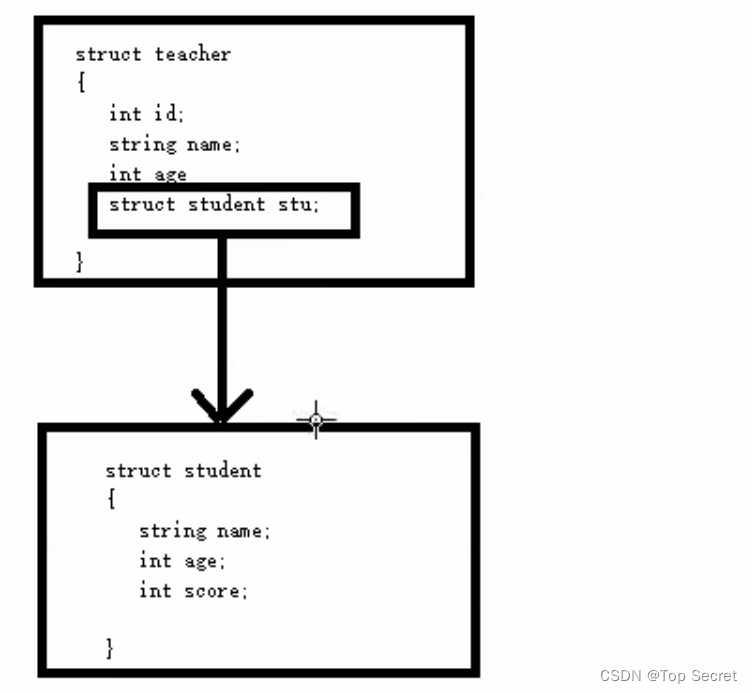
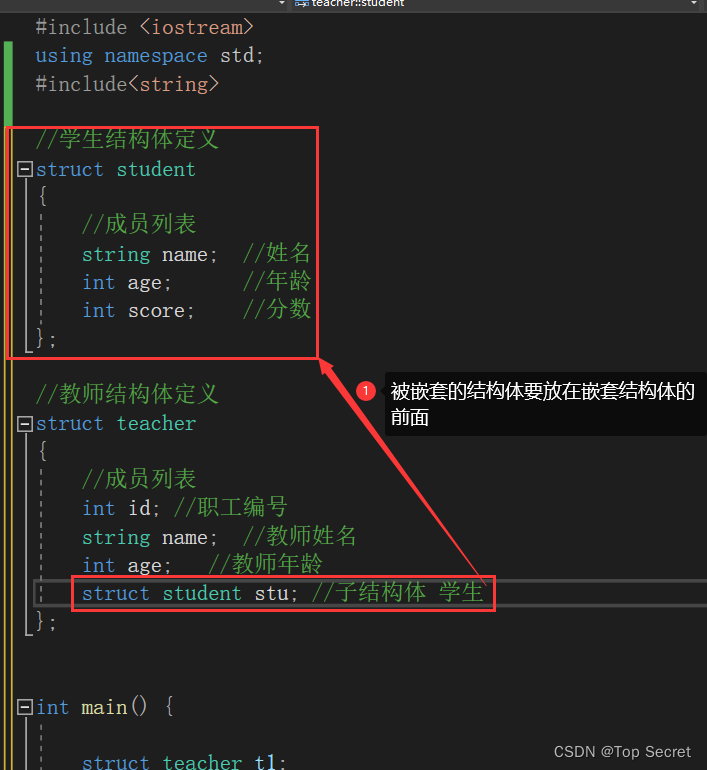
示例:
#include <iostream>
using namespace std;
#include<string>
//学生结构体定义
struct student
{
//成员列表
string name; //姓名
int age; //年龄
int score; //分数
};
//教师结构体定义
struct teacher
{
//成员列表
int id; //职工编号
string name; //教师姓名
int age; //教师年龄
struct student stu; //子结构体 学生
};
int main() {
struct teacher t1;
t1.id = 10000;
t1.name = "老王";
t1.age = 40;
t1.stu.name = "张三";
t1.stu.age = 18;
t1.stu.score = 100;
cout << "教师 职工编号: " << t1.id << " 姓名: " << t1.name << " 年龄: " << t1.age << endl;
cout << "辅导学员 姓名: " << t1.stu.name << " 年龄:" << t1.stu.age << " 考试分数: " << t1.stu.score << endl;
system("pause");
return 0;
}
总结:在结构体中可以定义另一个结构体作为成员,用来解决实际问题
6. 结构体做函数参数
作用:将结构体作为参数向函数中传递
传递方式有两种:
-
值传递
-
地址传递
示例:
#include <iostream>
using namespace std;
#include<string>
//学生结构体定义
struct student
{
//成员列表
string name; //姓名
int age; //年龄
int score; //分数
};
//值传递
void printStudent(student stu)
{
stu.age = 28; // 值传递中可以改变实参的值
cout << "结构体值传递的方式:" << endl;
cout << "子函数中 姓名:" << stu.name << " 年龄: " << stu.age << " 分数:" << stu.score << endl;
}
//地址传递
void printStudent2(student* stu)
{
cout << "结构体地址传递的方式:" << endl;
stu->age = 28; // 地址传递中可以改变实参的值
cout << "子函数中 姓名:" << stu->name << " 年龄: " << stu->age << " 分数:" << stu->score << endl;
}
int main() {
student stu = { "张三",18,100 };
//值传递
printStudent(stu);
cout << "主函数中 姓名:" << stu.name << " 年龄: " << stu.age << " 分数:" << stu.score << endl;
cout << endl;
//地址传递
printStudent2(&stu);
cout << "主函数中 姓名:" << stu.name << " 年龄: " << stu.age << " 分数:" << stu.score << endl;
system("pause");
return 0;
}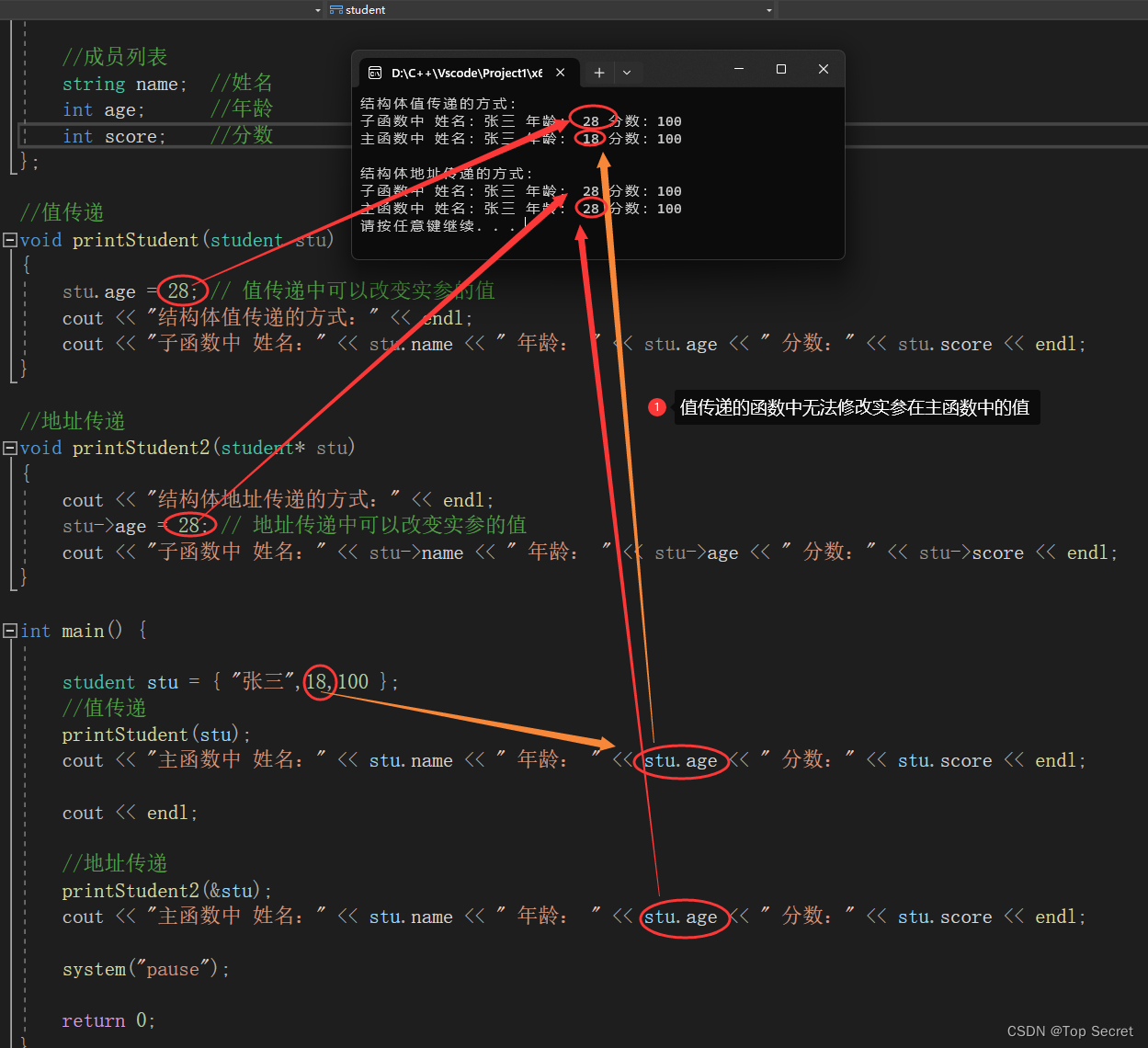
总结:如果不想修改主函数中的数据,用值传递,反之用地址传递
7. 结构体中 const使用场景
作用:用const来防止误操作
示例:
#include <iostream>
using namespace std;
#include<string>
//学生结构体定义
struct student
{
//成员列表
string name; //姓名
int age; //年龄
int score; //分数
};
// const使用场景
// 将函数中的形参改为指针,可以减小内存空间,而且不会复制新的副本出来
void printStudent(const student* stu) //加const防止函数体中的误操作
{
//stu->age = 100; //操作失败,因为加了const修饰
cout << "姓名:" << stu->name << " 年龄:" << stu->age << " 分数:" << stu->score << endl;
}
int main() {
student stu = { "张三",18,100 };
printStudent(&stu);
system("pause");
return 0;
}说明: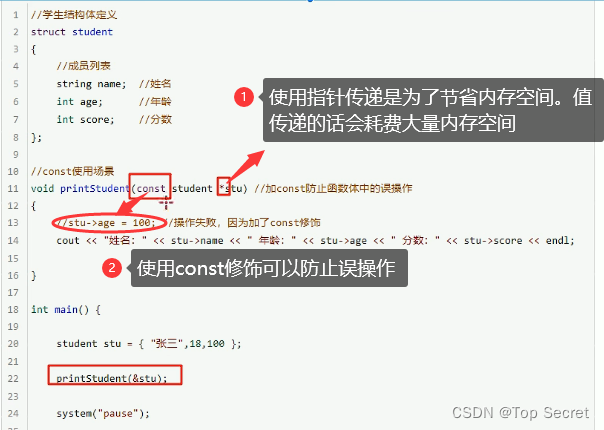
8. 结构体案例
8.1 案例1
案例描述:
学校正在做毕设项目,每名老师带领5个学生,总共有3名老师,需求如下:
设计学生和老师的结构体,其中在老师的结构体中,有老师姓名和一个存放5名学生的数组作为成员。
学生的成员有姓名、考试分数,创建数组存放3名老师,通过函数给每个老师及所带的学生赋值
最终打印出老师数据以及老师所带的学生数据。
示例:
struct Student
{
string name;
int score;
};
struct Teacher
{
string name;
Student sArray[5];
};
void allocateSpace(Teacher tArray[] , int len)
{
string tName = "教师";
string sName = "学生";
string nameSeed = "ABCDE";
for (int i = 0; i < len; i++)
{
tArray[i].name = tName + nameSeed[i];
for (int j = 0; j < 5; j++)
{
tArray[i].sArray[j].name = sName + nameSeed[j];
tArray[i].sArray[j].score = rand() % 61 + 40;
}
}
}
void printTeachers(Teacher tArray[], int len)
{
for (int i = 0; i < len; i++)
{
cout << tArray[i].name << endl;
for (int j = 0; j < 5; j++)
{
cout << "\t姓名:" << tArray[i].sArray[j].name << " 分数:" << tArray[i].sArray[j].score << endl;
}
}
}
int main() {
srand((unsigned int)time(NULL)); //随机数种子 头文件 #include <ctime>
Teacher tArray[3]; //老师数组
int len = sizeof(tArray) / sizeof(Teacher);
allocateSpace(tArray, len); //创建数据
printTeachers(tArray, len); //打印数据
system("pause");
return 0;
}8.2 案例2
案例描述:
设计一个英雄的结构体,包括成员姓名,年龄,性别;创建结构体数组,数组中存放5名英雄。
通过冒泡排序的算法,将数组中的英雄按照年龄进行升序排序,最终打印排序后的结果。
五名英雄信息如下:
{"刘备",23,"男"},
{"关羽",22,"男"},
{"张飞",20,"男"},
{"赵云",21,"男"},
{"貂蝉",19,"女"},
示例:
//英雄结构体
struct hero
{
string name;
int age;
string sex;
};
//冒泡排序
void bubbleSort(hero arr[] , int len)
{
for (int i = 0; i < len - 1; i++)
{
for (int j = 0; j < len - 1 - i; j++)
{
if (arr[j].age > arr[j + 1].age)
{
hero temp = arr[j];
arr[j] = arr[j + 1];
arr[j + 1] = temp;
}
}
}
}
//打印数组
void printHeros(hero arr[], int len)
{
for (int i = 0; i < len; i++)
{
cout << "姓名: " << arr[i].name << " 性别: " << arr[i].sex << " 年龄: " << arr[i].age << endl;
}
}
int main() {
struct hero arr[5] =
{
{"刘备",23,"男"},
{"关羽",22,"男"},
{"张飞",20,"男"},
{"赵云",21,"男"},
{"貂蝉",19,"女"},
};
int len = sizeof(arr) / sizeof(hero); //获取数组元素个数
bubbleSort(arr, len); //排序
printHeros(arr, len); //打印
system("pause");
return 0;
}